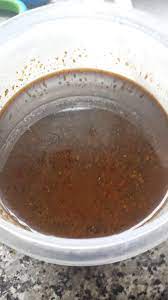Murri (condiment)

Murrī or almorí (in Andalusia) was a type of fermented condiment made with barley flour, known from Maghrebi and Arab cuisines. Almost every substantial dish in medieval Arab cuisine used murrī in small quantities. It could be used as a substitute for salt or sumac, and has been compared to soy sauce by Rudolf Grewe, Charles Perry, and others due to its high glutamates content and resultant umami flavor.[1][2]
There are two types of murri known from historical recipes that have survived into the present day. The Iraqi style murri from the 10th century Kitab al-Tabikh by Ibn Sayyar al-Warraq and the 13th century Kitab Wasf al-Atima al-Mutada was made by wetting a combination of ground flatbread, barley flour (budhaj flour) and salt and allowing it to ferment.[3]
The Maghrebi style of murri described in detail in Kitab Wasf is made only with barley flour, and flavored with carob, fennel stems, citron, pine nuts, mixed spices and bitter orange wood. The consistency is similar to treacle.[3]
Kitab Wasf also describes a “Byzantine murri”, but it is made with toasted bread instead of spoiled bread and includes caramelized honey.[3]
The authors of some Arabic lexicographical wrote that murri may be a word of foreign origin, and based on this some modern scholars have speculated that the word could be derived from the Greek halmyris (‘a salty thing’ and source for the Latin word for brine, salmuria) and related to the Ancient Roman condiment garum (or garos in Greek). Although murri is not made with fish, the Arabic translation of Artemidorus’ Oneirocritica uses garos for murri. While calling this “a translator’s ‘bright idea'”, Charles Perry, an expert in medieval Arab cuisine, notes that both condiments do share the traits of being fermented, salty liquid seasonings, but it is unknown whether the technique or culinary use of a fermented sauce is of Greek origin. Perry writes that murri may represent “the Greek idea of a salty liquid seasoning as interpreted in the basically Persianized—and fish poor—Near Eastern environment,” but cautions that this interpretation has some problems, including recorded recipes of a distinct “Byzantine murri”.[3] David Waines, a British scholar of Islamic history, has written that there are two types of murri, “the more usual made from barley flour, and the other from fish.” He further explains:[4]
